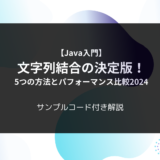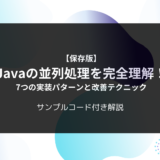はじめに
文字コード変換は、Javaアプリケーション開発において避けて通れない重要なテーマです。特に、異なるシステム間でのデータ連携や、レガシーシステムとの統合において、適切な文字コード処理は必須のスキルとなります。
なぜ今、文字コード変換が重要なのか?
1. システム統合の増加
● クラウドサービスとの連携
● マイクロサービスアーキテクチャの採用
● レガシーシステムのモダナイズ
2. グローバル化への対応
● 多言語対応の必要性
● 国際的なデータ交換の増加
● 文字化け問題の防止
3. データ品質の担保
● 正確なデータ変換の要求
● 文字化けによるビジネスリスクの回避
● システム間連携の信頼性確保
本記事で学べること
本記事では、Java開発者が直面する文字コード変換の課題に対して、実践的な解決方法を提供します。
● 基礎から応用まで段階的に学習
● 実装例とベストプラクティスの紹介
● トラブルシューティング手法の解説
● パフォーマンス最適化のテクニック
初心者から中級者まで、実務で必要となる文字コード変換の知識を体系的に解説していきます。
前提知識
本記事を理解するために必要な前提知識は以下の通りです。
● Java基本文法の理解
● ファイル入出力の基礎知識
● 例外処理の基本概念
それでは、Javaでの文字コード変換について、実践的な手順とともに詳しく見ていきましょう。
1.Javaでの文字コード変換の基礎知識
1.1 文字コードとは?エンコーディングの基本を理解しよう
文字コードとは、コンピュータ上でテキストデータを扱うための規則です。コンピュータは内部ではすべてのデータをバイナリ(0と1)で処理するため、人間が読める文字との間で相互変換が必要となります。
文字コードの基本概念
| 用語 | 説明 |
|---|---|
| 文字セット | 文字の集合(例:ASCII、JIS X 0208) |
| エンコーディング | 文字をバイト列に変換する規則 |
| デコーディング | バイト列を文字に変換する規則 |
変換の基本プロセス
文字列 → [エンコーディング] → バイト列 バイト列 → [デコーディング] → 文字列
1.2 Javaが標準でサポートする主要な文字コード規格
Javaは以下の主要な文字コード規格をサポートしています。
1. UTF-8
● 可変長エンコーディング
● ASCII互換
● 世界中の文字を扱える
● Webでの標準的な文字コード
2. UTF-16
● Javaの内部文字表現
● 16ビット単位で文字を表現
● サロゲートペアで拡張文字を表現
3. Shift-JIS
● 日本語Windows環境での標準
● レガシーシステムとの互換性に重要
4. ISO-8859-1
● 西欧言語用の8ビット文字コード
● レガシーシステムでよく使用
5. EUC-JP
● UNIXシステムでの日本語標準
● 主にレガシーシステムで使用
1.3 文字コード変換が必要になるケース5選
1. ファイル入出力処理
● テキストファイルの読み書き
● 設定ファイルの処理
// ファイル読み込み時の文字コード指定
try (BufferedReader reader = new BufferedReader(
new InputStreamReader(
new FileInputStream("input.txt"), "UTF-8"))) {
// ファイル処理
}
2. Web APIとの通信
● HTTPリクエスト/レスポンスの処理
● JSONデータの送受信
// Web APIレスポンスの文字コード処理
String response = new String(
responseBytes, StandardCharsets.UTF_8);
3. データベース連携
● DBMSとの文字コードの違いを吸収
● 異なる文字コード間のデータ移行
// データベース接続時の文字コード指定 String url = "jdbc:mysql://localhost/db?characterEncoding=UTF-8";
4. レガシーシステムとの連携
● 古いシステムとの文字コードの違いを解消
● 異なるプラットフォーム間のデータ交換
// レガシーシステムのデータを現行システム用に変換
String modernText = new String(
legacyData.getBytes("Shift-JIS"),
StandardCharsets.UTF_8);
5. 国際化対応
● 多言語対応システムの開発
● 地域ごとの文字コード要件への対応
// 地域に応じた文字コード処理
Charset charset = Charset.forName(
Locale.getDefault().toString());
これらの基礎知識を踏まえた上で、次章では具体的な実装方法について解説していきます。
2.Java文字コード変換の実装方法
2.1 String.getBytes()メソッドを使用した基本的な変換手順
String.getBytes()メソッドは、最も基本的な文字コード変換手段を提供します。以下に主要な使用パターンを示します。
public class CharacterEncodingExample {
public static void main(String[] args) throws Exception {
String originalText = "こんにちは世界"; // サンプルテキスト
// 方法1: 明示的な文字コード指定
byte[] utf8Bytes = originalText.getBytes("UTF-8");
byte[] sjisBytes = originalText.getBytes("Shift-JIS");
// 方法2: StandardCharsets使用(推奨)
byte[] utf8BytesStandard = originalText.getBytes(StandardCharsets.UTF_8);
// バイト配列から文字列への変換
String utf8Text = new String(utf8Bytes, StandardCharsets.UTF_8);
String sjisText = new String(sjisBytes, "Shift-JIS");
// 文字コードの確認
System.out.println("UTF-8バイト数: " + utf8Bytes.length);
System.out.println("Shift-JISバイト数: " + sjisBytes.length);
}
}
- 必ず文字コードを明示的に指定する
- try-catchによる例外処理を忘れずに実装
- StandardCharsets使用を推奨(タイプセーフ)
2.2 InputStreamReaderとOutputStreamWriterの活用術
ストリーム処理による文字コード変換は、大容量データの処理に適しています。
public class StreamEncodingExample {
public static void convertEncoding(String inputFile, String outputFile,
String fromEncoding, String toEncoding) {
// バッファサイズの最適化
final int BUFFER_SIZE = 8192;
try (BufferedReader reader = new BufferedReader(
new InputStreamReader(
new FileInputStream(inputFile), fromEncoding), BUFFER_SIZE);
BufferedWriter writer = new BufferedWriter(
new OutputStreamWriter(
new FileOutputStream(outputFile), toEncoding), BUFFER_SIZE)) {
String line;
while ((line = reader.readLine()) != null) {
writer.write(line);
writer.newLine();
}
} catch (IOException e) {
// エラーログの出力
logger.error("文字コード変換中にエラーが発生しました", e);
throw new RuntimeException("変換処理に失敗しました", e);
}
}
}
- バッファサイズの適切な設定
- try-with-resourcesの使用
- 適切なエラーハンドリング
- ログ出力の実装
2.3 Files.readAllLines()による効率的なファイル読み込みと文字コード指定
Java 7以降では、Files APIを使用した簡潔な実装が可能です。
public class FilesApiExample {
public static List<String> readAndConvertFile(Path filePath, Charset charset) {
try {
// ファイル全体を一度に読み込み
List<String> lines = Files.readAllLines(filePath, charset);
// 必要に応じて文字コード変換を実行
List<String> convertedLines = lines.stream()
.map(line -> new String(
line.getBytes(charset),
StandardCharsets.UTF_8))
.collect(Collectors.toList());
return convertedLines;
} catch (IOException e) {
logger.error("ファイル読み込み中にエラーが発生しました", e);
throw new UncheckedIOException(e);
}
}
public static void writeConvertedFile(Path filePath,
List<String> lines,
Charset charset) {
try {
Files.write(filePath, lines, charset,
StandardOpenOption.CREATE,
StandardOpenOption.TRUNCATE_EXISTING);
} catch (IOException e) {
logger.error("ファイル書き込み中にエラーが発生しました", e);
throw new UncheckedIOException(e);
}
}
}
- コードの簡潔さ
- 例外処理の統一性
- パフォーマンスの最適化
- 豊富なオプション
- 大容量ファイルの場合はストリーム処理を検討
- 適切な文字コード指定
- エラー発生時の適切なリソース解放
- ファイルロックの考慮
これらの実装方法は、用途や要件に応じて適切に選択することが重要です。次章では、実際に発生する文字化けトラブルとその解決策について解説します。
3.文字化けトラブルの原因と解決策
3.1 よくある文字化けの原因と診断方法
主な文字化けパターンと原因
| 現象 | よくある原因 | 診断方法 |
|---|---|---|
????? | 未知の文字として認識 | バイトコードの確認 |
■■■■ | 文字化けを示す記号に置換 | エンコーディングの確認 |
æ–‡å— | UTF-8をISO-8859-1として誤認識 | バイトシーケンスの分析 |
� | BOMの誤処理 | ファイルヘッダーの確認 |
以下のコードで文字化けの診断が可能です。
public class EncodingDiagnostics {
public static void diagnoseEncoding(byte[] data) {
// バイトコードの16進数表示
StringBuilder hex = new StringBuilder();
for (byte b : data) {
hex.append(String.format("%02X ", b));
}
System.out.println("Hex: " + hex.toString());
// 代表的なエンコーディングで解読を試行
String[] encodings = {"UTF-8", "Shift-JIS", "ISO-8859-1", "EUC-JP"};
for (String encoding : encodings) {
try {
String decoded = new String(data, encoding);
System.out.printf("%s: %s%n", encoding, decoded);
} catch (UnsupportedEncodingException e) {
System.out.printf("%s: 未対応%n", encoding);
}
}
}
}
3.2 環境依存文字の正しい取り扱い方
環境依存文字による問題を防ぐための対策は以下の通り。
public class EnvironmentDependentCharacterHandler {
// 機種依存文字の置換マップ
private static final Map<String, String> REPLACEMENT_MAP = new HashMap<>();
static {
REPLACEMENT_MAP.put("①", "(1)");
REPLACEMENT_MAP.put("㈱", "(株)");
REPLACEMENT_MAP.put("℃", "度");
// 他の置換ルール
}
public static String replaceEnvironmentDependentChars(String input) {
String result = input;
for (Map.Entry<String, String> entry : REPLACEMENT_MAP.entrySet()) {
result = result.replace(entry.getKey(), entry.getValue());
}
return result;
}
public static boolean containsEnvironmentDependentChars(String input) {
// Unicode範囲チェック
for (int i = 0; i < input.length(); i++) {
char c = input.charAt(i);
if (Character.UnicodeBlock.of(c) == Character.UnicodeBlock.PRIVATE_USE_AREA) {
return true;
}
}
return false;
}
}
- 環境依存文字の検出
- 代替文字への置換
- Unicode正規化の適用
- 文字化け検証の自動化
3.3 文字コード判定ライブラリの活用テクニック
juniversalchardet(Mozilla製)の活用例:
public class CharsetDetectionExample {
public static Charset detectCharset(byte[] data) {
org.mozilla.universalchardet.UniversalDetector detector =
new org.mozilla.universalchardet.UniversalDetector(null);
try {
detector.handleData(data, 0, data.length);
detector.dataEnd();
String charsetName = detector.getDetectedCharset();
if (charsetName != null) {
return Charset.forName(charsetName);
}
} finally {
detector.reset();
}
// デフォルトはUTF-8
return StandardCharsets.UTF_8;
}
public static String readFileWithAutoDetection(Path filePath)
throws IOException {
byte[] data = Files.readAllBytes(filePath);
Charset detectedCharset = detectCharset(data);
return new String(data, detectedCharset);
}
}
- 複数の判定手法の組み合わせ
- コンフィデンスレベルの確認
- フォールバックメカニズムの実装
- キャッシュの活用
文字化け問題の多くは、適切な診断と体系的なアプローチにより解決可能です。次章では、より実践的なコード例と応用テクニックについて解説します。
4.実践的なコード例と応用テクニック
4.1 Shift-JISからUTF-8への変換実装例
以下に、実務でよく必要となるShift-JISからUTF-8への変換処理の完全な実装例を示します。
public class EncodingConverter {
private static final Logger logger = LoggerFactory.getLogger(EncodingConverter.class);
public static class ConversionResult {
private final boolean success;
private final String message;
private final List<String> convertedLines;
public ConversionResult(boolean success, String message, List<String> convertedLines) {
this.success = success;
this.message = message;
this.convertedLines = convertedLines;
}
// getterメソッド省略
}
public static ConversionResult convertShiftJISToUTF8(Path inputPath, Path outputPath) {
List<String> convertedLines = new ArrayList<>();
StringBuilder errorMessage = new StringBuilder();
try (BufferedReader reader = new BufferedReader(
new InputStreamReader(
new FileInputStream(inputPath.toFile()), "Shift-JIS"));
BufferedWriter writer = new BufferedWriter(
new OutputStreamWriter(
new FileOutputStream(outputPath.toFile()), StandardCharsets.UTF_8))) {
String line;
int lineNumber = 0;
while ((line = reader.readLine()) != null) {
lineNumber++;
try {
// 文字化けチェック
if (containsGarbledCharacters(line)) {
errorMessage.append(String.format("Warning: Line %d may contain garbled characters%n", lineNumber));
}
// BOMの除去(必要な場合)
line = removeBOM(line);
// 変換処理
String convertedLine = new String(
line.getBytes("Shift-JIS"),
StandardCharsets.UTF_8);
convertedLines.add(convertedLine);
writer.write(convertedLine);
writer.newLine();
} catch (Exception e) {
errorMessage.append(String.format("Error at line %d: %s%n", lineNumber, e.getMessage()));
}
}
return new ConversionResult(
errorMessage.length() == 0,
errorMessage.toString(),
convertedLines
);
} catch (IOException e) {
logger.error("File conversion failed", e);
return new ConversionResult(
false,
"File conversion failed: " + e.getMessage(),
Collections.emptyList()
);
}
}
private static boolean containsGarbledCharacters(String text) {
// 文字化けの典型的なパターンをチェック
return text.contains("�") || text.matches(".*[\\ufffd\\ufffe\\uffff].*");
}
private static String removeBOM(String text) {
// BOMが存在する場合は除去
return text.startsWith("\uFEFF") ? text.substring(1) : text;
}
}
4.2 バイナリデータを含むテキストの安全な変換方法
バイナリデータが混在する可能性があるテキストを安全に処理する方法を示します。
public class BinaryAwareConverter {
// バイナリデータの検出閾値
private static final double BINARY_THRESHOLD = 0.30;
public static class ConversionResult {
private final byte[] convertedData;
private final boolean containsBinary;
private final String encoding;
// コンストラクタとgetterは省略
}
public static ConversionResult convertWithBinaryCheck(byte[] input, String sourceEncoding, String targetEncoding) {
try {
// バイナリデータチェック
if (isBinaryData(input)) {
// バイナリデータの場合は変換せずにそのまま返す
return new ConversionResult(input, true, sourceEncoding);
}
// テキストデータの変換
String text = new String(input, sourceEncoding);
byte[] converted = text.getBytes(targetEncoding);
return new ConversionResult(converted, false, targetEncoding);
} catch (UnsupportedEncodingException e) {
throw new RuntimeException("Encoding not supported", e);
}
}
private static boolean isBinaryData(byte[] data) {
if (data.length == 0) return false;
int controlChars = 0;
for (byte b : data) {
if (b < 32 && b != 9 && b != 10 && b != 13) {
controlChars++;
}
}
return (double) controlChars / data.length > BINARY_THRESHOLD;
}
}
4.3 大容量ファイルの効率的な文字コード変換テクニック
大容量ファイルを効率的に処理するためのストリーミング実装例を示します。
public class LargeFileConverter {
private static final int BUFFER_SIZE = 8192;
private static final int MAX_MEMORY_USAGE = 1024 * 1024 * 10; // 10MB
public static void convertLargeFile(Path inputPath, Path outputPath,
String sourceEncoding, String targetEncoding)
throws IOException {
// テンポラリファイルの作成
Path tempFile = Files.createTempFile("encoding_conversion", ".tmp");
try (FileChannel inputChannel = FileChannel.open(inputPath, StandardOpenOption.READ);
FileChannel outputChannel = FileChannel.open(tempFile,
StandardOpenOption.WRITE,
StandardOpenOption.CREATE)) {
// メモリマップドファイルを使用した効率的な処理
long fileSize = inputChannel.size();
long position = 0;
while (position < fileSize) {
long remainingSize = fileSize - position;
long mappingSize = Math.min(remainingSize, MAX_MEMORY_USAGE);
MappedByteBuffer buffer = inputChannel
.map(FileChannel.MapMode.READ_ONLY, position, mappingSize);
// バッファからデータを読み込み
byte[] data = new byte[(int) mappingSize];
buffer.get(data);
// 文字コード変換
String text = new String(data, sourceEncoding);
byte[] convertedData = text.getBytes(targetEncoding);
// 変換したデータを書き込み
ByteBuffer outputBuffer = ByteBuffer.wrap(convertedData);
outputChannel.write(outputBuffer);
position += mappingSize;
}
}
// 完了したら一時ファイルを本番ファイルに移動
Files.move(tempFile, outputPath, StandardCopyOption.REPLACE_EXISTING);
}
// 進捗監視用のラッパーメソッド
public static void convertLargeFileWithProgress(Path inputPath, Path outputPath,
String sourceEncoding, String targetEncoding,
ProgressCallback callback) {
try {
long totalSize = Files.size(inputPath);
AtomicLong processedSize = new AtomicLong(0);
// 進捗報告用スレッドの開始
ScheduledExecutorService executor = Executors.newSingleThreadScheduledExecutor();
executor.scheduleAtFixedRate(() -> {
double progress = (double) processedSize.get() / totalSize * 100;
callback.onProgress(progress);
}, 0, 1, TimeUnit.SECONDS);
// 変換処理の実行
convertLargeFile(inputPath, outputPath, sourceEncoding, targetEncoding);
// 進捗報告用スレッドの停止
executor.shutdown();
callback.onComplete();
} catch (IOException e) {
callback.onError(e);
}
}
@FunctionalInterface
public interface ProgressCallback {
void onProgress(double percentage);
default void onComplete() {}
default void onError(Exception e) {}
}
}
これらの実装例は、実務での様々なユースケースに対応できるよう設計されています。次章では、これらの実装におけるパフォーマンスとベストプラクティスについて詳しく解説します。
5.パフォーマンスとベストプラクティス
5.1 文字コード変換処理の最適化テクニック
パフォーマンス最適化の基本戦略
public class EncodingPerformanceOptimizer {
// 最適なバッファサイズの決定
private static final int OPTIMAL_BUFFER_SIZE = 8192; // 8KB
public static class PerformanceMetrics {
private long executionTime;
private long memoryUsage;
private int throughput;
// getterとsetterは省略
}
public static PerformanceMetrics convertWithMetrics(Path input, Path output,
String sourceEncoding,
String targetEncoding) {
PerformanceMetrics metrics = new PerformanceMetrics();
Runtime runtime = Runtime.getRuntime();
// メモリ使用量の初期値を記録
long initialMemory = runtime.totalMemory() - runtime.freeMemory();
long startTime = System.nanoTime();
try (BufferedReader reader = new BufferedReader(
new InputStreamReader(
new FileInputStream(input.toFile()),
sourceEncoding),
OPTIMAL_BUFFER_SIZE);
BufferedWriter writer = new BufferedWriter(
new OutputStreamWriter(
new FileOutputStream(output.toFile()),
targetEncoding),
OPTIMAL_BUFFER_SIZE)) {
// CharBufferを使用した効率的な処理
CharBuffer buffer = CharBuffer.allocate(OPTIMAL_BUFFER_SIZE);
char[] chars = new char[OPTIMAL_BUFFER_SIZE];
int read;
while ((read = reader.read(chars)) != -1) {
buffer.put(chars, 0, read);
buffer.flip();
writer.write(buffer.toString());
buffer.clear();
}
} catch (IOException e) {
logger.error("Conversion failed", e);
throw new RuntimeException(e);
}
// メトリクスの計算
long endTime = System.nanoTime();
long finalMemory = runtime.totalMemory() - runtime.freeMemory();
metrics.setExecutionTime(endTime - startTime);
metrics.setMemoryUsage(finalMemory - initialMemory);
return metrics;
}
}
最適化のポイント一覧
| 最適化項目 | 効果 | 実装方法 |
|---|---|---|
| バッファサイズ最適化 | I/O効率向上 | 8KB-64KBのバッファ使用 |
| メモリマッピング | 大容量ファイル処理 | FileChannel.map()使用 |
| 並列処理 | 処理速度向上 | ExecutorServiceの活用 |
| キャッシング | 重複処理の削減 | WeakHashMapの使用 |
5.2 メモリ使用量を考慮した実装方法
public class MemoryEfficientConverter {
private static final WeakHashMap<String, CharsetEncoder> encoderCache = new WeakHashMap<>();
private static final WeakHashMap<String, CharsetDecoder> decoderCache = new WeakHashMap<>();
public static void convertLargeFileMemoryEfficient(
Path input, Path output, String sourceEncoding, String targetEncoding) {
// エンコーダー/デコーダーの取得(キャッシュ利用)
CharsetEncoder encoder = getEncoder(targetEncoding);
CharsetDecoder decoder = getDecoder(sourceEncoding);
try (FileChannel inputChannel = FileChannel.open(input, StandardOpenOption.READ);
FileChannel outputChannel = FileChannel.open(output,
StandardOpenOption.WRITE,
StandardOpenOption.CREATE)) {
// チャンク単位での処理
ByteBuffer inputBuffer = ByteBuffer.allocate(8192);
ByteBuffer outputBuffer = ByteBuffer.allocate(8192);
CharBuffer charBuffer = CharBuffer.allocate(8192);
while (inputChannel.read(inputBuffer) != -1) {
inputBuffer.flip();
decoder.decode(inputBuffer, charBuffer, false);
charBuffer.flip();
encoder.encode(charBuffer, outputBuffer, false);
outputBuffer.flip();
outputChannel.write(outputBuffer);
inputBuffer.compact();
charBuffer.compact();
outputBuffer.compact();
}
// 残りのデータの処理
decoder.decode(inputBuffer, charBuffer, true);
encoder.encode(charBuffer, outputBuffer, true);
outputChannel.write(outputBuffer);
} catch (IOException e) {
throw new RuntimeException("Conversion failed", e);
}
}
private static synchronized CharsetEncoder getEncoder(String encoding) {
return encoderCache.computeIfAbsent(encoding,
e -> Charset.forName(e).newEncoder()
.onMalformedInput(CodingErrorAction.REPLACE)
.onUnmappableCharacter(CodingErrorAction.REPLACE));
}
private static synchronized CharsetDecoder getDecoder(String encoding) {
return decoderCache.computeIfAbsent(encoding,
e -> Charset.forName(e).newDecoder()
.onMalformedInput(CodingErrorAction.REPLACE)
.onUnmappableCharacter(CodingErrorAction.REPLACE));
}
}
5.3 ユニットテストによる文字コード変換の品質担保
@ExtendWith(MockitoExtension.class)
public class EncodingConverterTest {
private static final String TEST_STRING = "テスト文字列";
private static final Path TEST_DIR = Paths.get("target/test-files");
@BeforeEach
void setUp() throws IOException {
Files.createDirectories(TEST_DIR);
}
@Test
void testBasicConversion() throws Exception {
// テストファイルの準備
Path inputPath = TEST_DIR.resolve("input.txt");
Path outputPath = TEST_DIR.resolve("output.txt");
// Shift-JISでファイル作成
try (Writer writer = new OutputStreamWriter(
new FileOutputStream(inputPath.toFile()), "Shift-JIS")) {
writer.write(TEST_STRING);
}
// 変換実行
EncodingConverter.convertShiftJISToUTF8(inputPath, outputPath);
// 結果検証
String result = Files.readString(outputPath, StandardCharsets.UTF_8);
assertEquals(TEST_STRING, result);
}
@Test
void testLargeFileConversion() throws Exception {
// 大容量テストデータ生成
StringBuilder largeContent = new StringBuilder();
for (int i = 0; i < 100000; i++) {
largeContent.append(TEST_STRING).append("\n");
}
Path inputPath = TEST_DIR.resolve("large_input.txt");
Path outputPath = TEST_DIR.resolve("large_output.txt");
// ファイル作成と変換テスト
Files.writeString(inputPath, largeContent.toString(),
Charset.forName("Shift-JIS"));
// メモリ使用量を監視しながら変換
Runtime runtime = Runtime.getRuntime();
long beforeMemory = runtime.totalMemory() - runtime.freeMemory();
LargeFileConverter.convertLargeFile(inputPath, outputPath,
"Shift-JIS", "UTF-8");
long afterMemory = runtime.totalMemory() - runtime.freeMemory();
// メモリリーク確認
assertTrue((afterMemory - beforeMemory) < 50 * 1024 * 1024); // 50MB以下
// 内容検証
try (BufferedReader reader = Files.newBufferedReader(outputPath,
StandardCharsets.UTF_8)) {
String firstLine = reader.readLine();
assertEquals(TEST_STRING, firstLine);
}
}
}
テスト実装のベストプラクティス
1. エッジケースの網羅
● 空ファイル
● 特殊文字を含むファイル
● 大容量ファイル
● 壊れたエンコーディング
2. パフォーマンステスト
● 実行時間の計測
● メモリ使用量の監視
● スケーラビリティの確認
3. 異常系のテスト
● 不正な入力の処理
● リソース制約下での動作
● 例外処理の確認
これらの実装とテストにより、高品質な文字コード変換処理を実現できます。次章では、実際のトラブルシューティング手法について解説します。
6.トラブルシューティングガイド
6.1 変換時のエラーハンドリング実装例
包括的なエラーハンドリングの実装
public class EncodingTroubleshooter {
private static final Logger logger = LoggerFactory.getLogger(EncodingTroubleshooter.class);
public static class ConversionResult {
private final boolean success;
private final List<String> warnings;
private final List<String> errors;
private final Map<String, Object> diagnosticInfo;
// コンストラクタ、getterは省略
}
public static ConversionResult safeConvert(Path input, Path output,
String sourceEncoding,
String targetEncoding) {
List<String> warnings = new ArrayList<>();
List<String> errors = new ArrayList<>();
Map<String, Object> diagnosticInfo = new HashMap<>();
try {
// ファイルの存在確認
if (!Files.exists(input)) {
throw new FileNotFoundException("Input file not found: " + input);
}
// エンコーディングの有効性確認
validateEncoding(sourceEncoding, targetEncoding);
// ファイルサイズチェック
long fileSize = Files.size(input);
diagnosticInfo.put("fileSize", fileSize);
// BOMチェック
boolean hasBOM = checkBOM(input);
diagnosticInfo.put("hasBOM", hasBOM);
// 文字コード判定
String detectedEncoding = detectEncoding(input);
diagnosticInfo.put("detectedEncoding", detectedEncoding);
if (!detectedEncoding.equals(sourceEncoding)) {
warnings.add("Detected encoding differs from specified: " +
detectedEncoding);
}
// 変換実行
performConversion(input, output, sourceEncoding, targetEncoding);
// 変換結果の検証
validateConversion(output, targetEncoding);
return new ConversionResult(true, warnings, errors, diagnosticInfo);
} catch (Exception e) {
logger.error("Conversion failed", e);
errors.add(e.getMessage());
return new ConversionResult(false, warnings, errors, diagnosticInfo);
}
}
private static void validateEncoding(String source, String target) {
try {
if (!Charset.isSupported(source)) {
throw new IllegalArgumentException(
"Source encoding not supported: " + source);
}
if (!Charset.isSupported(target)) {
throw new IllegalArgumentException(
"Target encoding not supported: " + target);
}
} catch (IllegalCharsetNameException e) {
throw new IllegalArgumentException("Invalid charset name", e);
}
}
private static String detectEncoding(Path file) throws IOException {
byte[] bytes = Files.readAllBytes(file);
UniversalDetector detector = new UniversalDetector(null);
detector.handleData(bytes, 0, bytes.length);
detector.dataEnd();
String encoding = detector.getDetectedCharset();
detector.reset();
return encoding != null ? encoding : "UTF-8";
}
}
6.2 文字化け発生時のデバッグ手順
デバッグツールの実装例
public class EncodingDebugger {
public static class DebugInfo {
private final byte[] rawBytes;
private final Map<String, String> encodingAttempts;
private final List<String> abnormalPatterns;
// コンストラクタ、getterは省略
}
public static DebugInfo analyzeText(String text, String expectedEncoding) {
byte[] rawBytes = text.getBytes(Charset.forName(expectedEncoding));
Map<String, String> encodingAttempts = new HashMap<>();
List<String> abnormalPatterns = new ArrayList<>();
// 各種エンコーディングでの変換を試行
for (String encoding : Arrays.asList("UTF-8", "Shift-JIS", "ISO-8859-1")) {
try {
String converted = new String(rawBytes, encoding);
encodingAttempts.put(encoding, converted);
// 異常パターンの検出
if (containsAbnormalPattern(converted)) {
abnormalPatterns.add(String.format(
"Abnormal pattern found in %s encoding", encoding));
}
} catch (Exception e) {
encodingAttempts.put(encoding, "Conversion failed: " + e.getMessage());
}
}
// バイトパターンの分析
analyzeBytePatterns(rawBytes, abnormalPatterns);
return new DebugInfo(rawBytes, encodingAttempts, abnormalPatterns);
}
private static boolean containsAbnormalPattern(String text) {
// 文字化けの典型的なパターンをチェック
return text.contains("?") ||
text.contains("�") ||
text.matches(".*[\\ufffd\\ufffe\\uffff].*");
}
private static void analyzeBytePatterns(byte[] bytes,
List<String> abnormalPatterns) {
// UTF-8のバイトパターンチェック
for (int i = 0; i < bytes.length; i++) {
if ((bytes[i] & 0x80) == 0x80) { // マルチバイト文字の開始
if ((bytes[i] & 0xE0) == 0xE0) { // 3バイト文字
if (i + 2 >= bytes.length ||
(bytes[i + 1] & 0xC0) != 0x80 ||
(bytes[i + 2] & 0xC0) != 0x80) {
abnormalPatterns.add(
"Invalid UTF-8 3-byte sequence at position " + i);
}
}
}
}
}
}
6.3 環境間での文字コードの違いによるトラブル対策
環境差異に対応するユーティリティ
public class CrossPlatformEncodingUtil {
private static final String DEFAULT_ENCODING = StandardCharsets.UTF_8.name();
private static final Map<String, String> OS_ENCODING_MAP = new HashMap<>();
static {
OS_ENCODING_MAP.put("WINDOWS", "MS932");
OS_ENCODING_MAP.put("LINUX", "UTF-8");
OS_ENCODING_MAP.put("MAC", "UTF-8");
}
public static String determineSystemEncoding() {
String os = System.getProperty("os.name").toUpperCase();
String encoding = System.getProperty("file.encoding");
// OSごとのデフォルトエンコーディングをチェック
for (Map.Entry<String, String> entry : OS_ENCODING_MAP.entrySet()) {
if (os.contains(entry.getKey())) {
if (!encoding.equals(entry.getValue())) {
logger.warn("System encoding {} differs from recommended {} for {}",
encoding, entry.getValue(), entry.getKey());
}
return entry.getValue();
}
}
return DEFAULT_ENCODING;
}
public static void configureGlobalEncoding() {
// プロパティファイルの読み込み
try (InputStream input = CrossPlatformEncodingUtil.class
.getResourceAsStream("/encoding.properties")) {
if (input == null) {
logger.warn("encoding.properties not found, using defaults");
return;
}
Properties props = new Properties();
props.load(input);
// エンコーディング設定の適用
String configuredEncoding = props.getProperty("file.encoding");
if (configuredEncoding != null) {
System.setProperty("file.encoding", configuredEncoding);
updateFieldValue();
}
} catch (IOException e) {
logger.error("Failed to load encoding configuration", e);
}
}
private static void updateFieldValue() {
try {
Field charset = Charset.class.getDeclaredField("defaultCharset");
charset.setAccessible(true);
charset.set(null, null);
} catch (Exception e) {
logger.error("Failed to update default charset", e);
}
}
}
トラブル対策のベストプラクティス
1. システム設定の標準化
● プロジェクト全体で統一したエンコーディング設定
● 明示的なエンコーディング指定
● 環境変数による制御
2. 予防的な対策
● 定期的なエンコーディングチェック
● 自動テストの実装
● ログ監視の強化
3. トラブル発生時の対応
● 詳細なログ収集
● エンコーディング情報の可視化
● 段階的なトラブルシューティング
これらの実装により、文字コード関連の問題を効果的に特定し、解決することができます。次章では、全体のまとめと補足情報について解説します。
7.まとめと補足情報
7.1 文字コード変換実装のベストプラクティスまとめ
実装時の重要ポイント一覧
| カテゴリ | ベストプラクティス | 理由 |
|---|---|---|
| 基本設計 | 明示的な文字コード指定 | デフォルト値への依存を避ける |
| エラー処理 | 包括的な例外ハンドリング | 安定性と保守性の向上 |
| パフォーマンス | 適切なバッファサイズ | メモリ使用効率の最適化 |
| 品質管理 | 単体テストの充実 | 信頼性の確保 |
| 運用管理 | ログ出力の充実 | トラブルシューティングの効率化 |
実装チェックリスト
public class EncodingImplementationChecklist {
// 推奨される実装パターン
public static class RecommendedImplementation {
// 1. 文字コードの明示的な指定
private static final Charset DEFAULT_CHARSET = StandardCharsets.UTF_8;
// 2. リソースの適切な解放
public static void processFile(Path path) {
try (BufferedReader reader = Files.newBufferedReader(path, DEFAULT_CHARSET)) {
// 処理
}
}
// 3. エラーハンドリング
public static String convertSafely(byte[] input, String sourceEncoding) {
try {
return new String(input, sourceEncoding);
} catch (UnsupportedEncodingException e) {
logger.error("Encoding error", e);
return new String(input, DEFAULT_CHARSET);
}
}
}
}
7.2 Java 8以降での新機能と改善点
Java 8で導入された主な改善点
1. StandardCharsets
● 標準文字セットの定数化
● タイプセーフな文字コード指定
2. String.getBytes()の最適化
● パフォーマンスの向上
● メモリ効率の改善
Java 11以降の新機能
public class ModernEncodingFeatures {
public static void demonstrateModernFeatures() {
// Java 11: String#isBlank()
String text = " ";
boolean isEmpty = text.isBlank(); // true
// Java 11: String#strip()
String stripped = text.strip();
// Java 12: String#indent()
String indented = "Hello\nWorld".indent(4);
// Java 13: Text Blocks
String textBlock = """
{
"encoding": "UTF-8",
"content": "マルチライン文字列"
}
""";
}
}
7.3 さらなる学習のためのリソース紹介
推奨学習リソース
1. 技術文書
● Java Language Specification
● Unicode Standard Documentation
● Character Encoding Recommendations (W3C)
2. 実践的なトレーニング
● オンラインコース
● ハンズオンワークショップ
● コードレビュー実践
3. ツールとライブラリ
● ICU4J(International Components for Unicode)
● Apache Commons Text
● juniversalchardet
今後の学習ロードマップ
1. 基礎知識の強化
● Unicode標準の理解
● 文字エンコーディング理論
2. 実装スキルの向上
● パフォーマンスチューニング
● セキュリティ考慮事項
● 大規模システム対応
3. 応用分野の探求
● 国際化(i18n)
● 多言語処理
● 文字コード変換サービス
まとめ
文字コード変換は、Javaアプリケーション開発において重要な要素です。本記事で解説した内容を基に、以下の点に注意して実装を進めることをお勧めします。
1. 基本原則の遵守
● 明示的な文字コード指定
● 適切なエラーハンドリング
● パフォーマンスへの配慮
2. 実装の品質確保
● ユニットテストの作成
● コードレビューの実施
● ドキュメントの整備
3. 継続的な改善
● 新機能の活用
● パフォーマンス最適化
● セキュリティ対策
これらの知識と実践を組み合わせることで、文字化けトラブルから解放され、信頼性の高い文字コード処理を実現できます。



